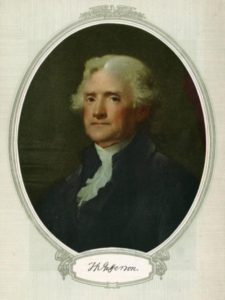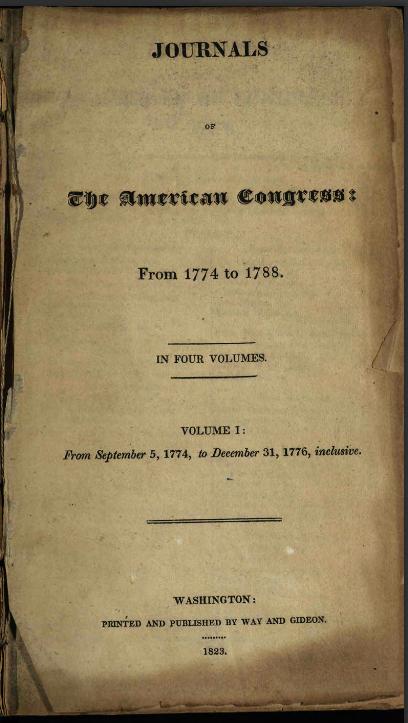The Committee of Five: Drafting the Declaration of Independence

In a blog post this past March, we shared with you The Genuine Principles of the Ancient Saxon, or English Constitution, which included the first version of the Declaration of Independence to be printed in book format. June 11 will mark 240 years since the Declaration’s drafters, called the “Committee of Five,” joined to create what would be one of our most significant founding documents.

Five men joined to create the Declaration: John Adams, Thomas Jefferson, Benjamin Franklin, Robert Livingston and Roger Sherman. The first three – Adams, Jefferson and Franklin – continue to be household names; three of Ohio’s counties are named after these men. John Adams was the first vice president of the United States, the second president, an ambassador to both Holland and Great Britain, a commissioner to France, and a successful and respected lawyer. Thomas Jefferson was a vice president under John Adams, the third president, the first Secretary of State, a minister to France, and the first Governor of Virginia. Benjamin Franklin’s skills, interests, and occupations were diverse, as well; he was the first president of Pennsylvania (that office is now held by the state’s governor), a minister to both Sweden and France, and the first Postmaster General, as well as being a printer, orator, author, scientist, philosopher, inventor, and diplomat.
Robert Livingston and Roger Sherman, though less well-known today, were no less significant during the colonial period and early days of the United States. Robert Livingston was born in New York and came to be known as “The Chancellor” after the office he held in his native state from 1777 to 1801. He was a lawyer and political leader, serving as a minister to France and as the first U.S. Secretary of Foreign Affairs. As New York’s senior judge, he administered George Washington’s first oath of office and, acting under the direction of Thomas Jefferson, negotiated the Louisiana Purchase. Incidentally, though Livingston was on the Committee of Five, he returned to New York prior to signing it. Roger Sherman was a native of Connecticut, was the second-oldest member of the Continental Congress (after Franklin) and was the only man to sign all four of the founding documents of the United States: the Continental Association, which established a trade boycott with Great Britain; the Declaration of Independence; the Articles of Confederation and the United States Constitution. His first careers were as a surveyor and a cordwainer (a maker of shoes and other leather items), but he spent the last thirty years of his life in political service. He was known to be sensible, and his control over his emotions led Thomas Jefferson to remark that he “never said a foolish thing in his life.”

The State Library of Ohio holds many United States federal documents in its collection, one being the Journals of the American Congress, which includes letters, resolutions (including the previously-mentioned Continental Association, found on page 46), and notes on the daily activities of the Continental Congress from 1774 to 1788. The first of four volumes includes mention of the formation of the Committee of Five on June 11, 1776, page 369: “Resolved, That the committee, for preparing the declaration, consist of five; The members chosen, Mr. Jefferson, Mr. J. Adams, Mr. Franklin, Mr. Sherman, and Mr. R. R. Livingston.”
The Committee of Five did not keep minutes of their meetings or deliberations. What is known is that the group of men worked together from June 11 to June 28, 1776, with Thomas Jefferson, at John Adams’ urging, writing the first draft of the document. No mention of the Declaration is made in the Journal until July 1 (page 392), when it was “resolved: that this Congress will, to-morrow, resolve itself into a committee of the whole, to take into consideration the declaration respecting independence.” The following day, Congress required additional deliberation regarding the Declaration, but resolved the following: “That these United Colonies are, and, of right, ought to be, Free and Independent States; that they are absolved from all allegiance to the British crown, and that all political connexion between them, and the state of Great-Britain, is, and ought to be, totally dissolved.” On July 3, Congress resolved to consider the declaration further but, by this point, was referring to the document as the Declaration of Independence. And, finally, on July 4, the language of the Declaration was agreed upon, the document was signed by the members of Congress, and plans were made for distribution beginning July 5. It was at this point the Committee of Five disbanded, with each of the men going down in history as Founding Fathers of the United States.
Though quite long, the Journal is a fascinating read, perfect for the weeks leading up to the Fourth of July, when we celebrate the signing and distribution of the document these five men created. We look forward to providing online access to the remaining volumes as we are able. Meanwhile, we hope you enjoy this addition to Ohio Memory!
Thank you to Shannon Kupfer, Digital Initiatives Librarian at theState Library of Ohio, for this week’s post!



Leave a Reply
You must be logged in to post a comment.